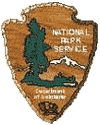

tooth enamel fragment and tooth root found at Sheep Rock
Prospecting at Sheep Rock
by Jennifer Chapman, JODA Staff - 6/22/98
Patience is a virtue and no less than ever when prospecting for microvertebrate fossils.
I accompanied John Day Fossil Beds field paleontologists Al Pajak and Scott Foss on a challenging hike up the south side of Sheep Rock to a typical day's work in search of small fossils that when found would be measured in millimeters. The slow, careful examination of the rock surface that ensued may be described as tedious by some, meditative by others, but today is compared to proof-reading by Al and Scott.
"We're building a database," they explain, noting that last year they worked the lower half of Sheep Rock, and this year they will work the upper half. The goal of the "Sheep Rock Prospecting Project" is a thorough inventory of this locality which was first done in 1982-1984 by Hugh Wagner, a contractor for the National Park Service, and later in 1990 by staff paleontologist Ted Fremd. Sheep Rock, the most prominent landform near the monument's headquarters, is one of over 200 sites that are routinely inspected for fossils as part of the resource management program at John Day Fossil Beds.
Al and Scott emphasized they are looking for absolutely anything, meaning they are consciously avoiding any collecting bias. By comparison, the early days of paleontology are notorious for collections of only large specimens with trophy, exhibit and perhaps expedition fundraising potential. Scientists today consider microfossils just as important as larger fossils in efforts to reconstruct ancient communities as completely as possible, rather than merely showcase individuals.
In addition to looking for small animals, microvertebrate prospecting involves looking for small specimens such as individual teeth which in mammals is often enough to identify a genus. Species level identification usually requires more than a single tooth, but often several consecutive teeth is enough. "Micro" should not be confused with microscopic, as this work is done within the limits of the human eye, but that does include detecting fossils that could be mistaken for grains of sand, such as the knee cap of a mouse.
The work site we visited was an exposure of Units G, H, and I in a series of rocks known as the Turtle Cove Member of the John Day Formation. This area is in the upper half of Sheep Rock, resting above the Picture Gorge Ignimbrite, the wide, hard, brown volcanic layer that runs through the center. Three layers at this site represent important geologic time brackets: the Picture Gorge Ignimbrite (28.7 million years ago); the Round Up Tuff (firm date not yet determined); and the Deep Creek Tuff (27.5 million years ago). Because these layers contain potassium rich minerals formed during volcanic events, they can be dated based on how much of the potassium has decayed to argon. Because these layers can be dated, fossils occuring between them are known to be from within specific time ranges. Today we worked in between the Picture Gorge Ignimbrite and the Round Up Tuff.
Patience. Approximately 4 hours of prospecting by all three of us resulted in only two moderately good finds: a tooth root, tentatively identified as belonging to some kind of dog...and a fragment of tooth enamel which may belong to Hypertragulus, the "mouse-deer". This same kind of careful work yielded the most significant find at Sheep Rock last year: a single primate tooth, measuring only 4 mm in width, but which verified that primates were endemic to North America until at least 26 million years ago; that they were here longer than once thought. That fossil was also found in the upper half of Sheep Rock, stratigraphically above where we worked today.
Microvertebrate prospecting in the John Day Formation is unconventional in that it lacks the screen sifting technique usually used with fossils on this scale. Normally fine mesh screen with 20-40 holes per inch (finer than window screen) would be used sift a slurry of fossiliferous sediment and water driving the finer clays away, and leaving sand and fossils in the seive. But the claystones of Sheep Rock are tightly cemented by silica derived from the volcanic ash that is their basic ingredient. The rocks are too hard to dissolve in water and thus, microfossils must be plucked from the surface with tweezer-like tools as the paleontologist crawls along the outcrop.
Microvertebrate screenwashing techniques were refined and standardized in the 1950's by Hibbard in his work with rodents. Scott's experience with microfossils includes screenwashing fossiliferous material from harverster ant mounds at Badlands National Park, while Al's includes looking for lizard teeth in California lake deposits, and sifting dasyurids and bandicots (rabbit and weasel equivalent marsupials) with mosquito net bags in Australia.
Even if screenwashing could be used on the John Day claystones, this technique would not be chosen by the monument's staff because the slower process of hands-and-knees prospecting produces the highest precision collections. Every time a fossil is removed from the rock, its location is carefully documented using aerial photograhs and vertical measurements from the nearest dateable layer. This is the most accurate way to place evidence of past life in the proper context of space and time.
What do we learn from all this patience and virtue? "In addition to when animals lived and what animals co-existed, we can also tell which animals were hopping, which were digging and which were tree climbing," says Al. "We can study evolution, systematics, and biostratigraphy," says Scott who adds, "I can also tell you that the timing of the first and last entelodonts (large pig-like animals) in North America corresponds with the beginning and ending of the John Day Formation."
fossil-record/2.htm
Last Updated: 09-Jan-2000